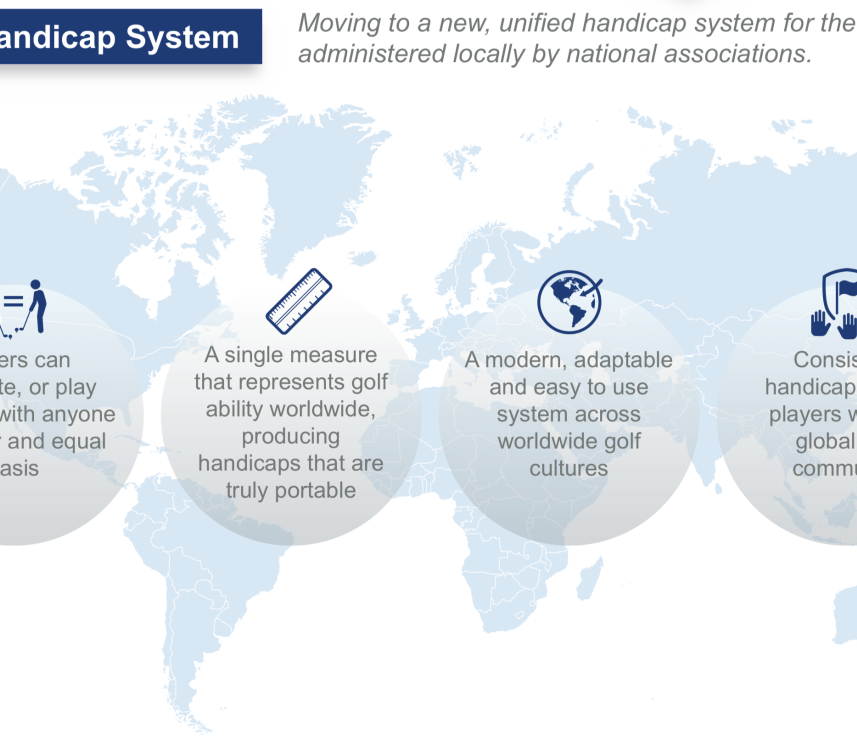
The R&A and the USGA, in collaboration with the EGA and the five other regional handicapping authorities, have announced key features of the proposed new World Handicap System (WHS). The new system is designed to provide all golfers with a consistent measure of playing ability globally.
The idea for a new, unified system was conceived by the The R&A and the USGA and developed following an extensive review of systems administered by six existing handicapping authorities - Golf Australia, the Council of National Golf Unions (CONGU) in Great Britain and Ireland, the European Golf Association (EGA), the South African Golf Association (SAGA), the Argentine Golf Association (AAG) and the United States Golf Association (USGA).
What is the World Handicap System (WHS)?
The World Handicap System (WHS) aims to bring six different handicap systems together into a single set of Rules for Handicapping, enabling golfers of different abilities to play and compete on a fair and equal basis, no matter how or where they play.
While the six existing handicap systems have generally worked very well locally, on a global basis, their different characteristics have sometimes resulted in inconsistency, with players of the same ability ending up with slightly different handicaps. This has sometimes resulted in unnecessary difficulties and challenges for golfers competing in handicap events or for tournament administrators. A single WHS will pave the way to consistency and portability.
What Main Features will the WHS have?
- The handicap will be calculated from the average of the best 8 of the last 20 eligible handicap rounds (no time limit), also featuring a balance between responsiveness and control, with memory of previously demonstrated playing ability and handicap. All the current formats of play in the EGA Handicap System, both for competitive and recreational rounds to count for handicap purposes, will be available.
- A minimal number of scores is needed to obtain a new handicap (by default: 54 holes) and EGA countries can continue to use a minimum of only one score. This also means that a valid handicap is calculated before the player has the 20 scores on his record.
- The USGA Course Rating System will continue to be used to rate courses, as part of the WHS and, therefore, portability from course to course and country to country will remain and be available at a larger scale.
- An included feature considers the impact of abnormal courses and weather conditions.
- Handicaps are immediately updated.
- The maximum score per hole for handicapping purposes continues to be the equivalent to zero Stableford points (net double bogey).
- The maximum handicap continues to be 54, for both genders, for an inclusive system.
Martin Slumbers, Chief Executive of the R&A, said, "We are working with our partners and National Associations to make golf more modern, more accessible and more enjoyable as a sport and the new World Handicap System represents a huge opportunity in this regard. We want to make it more attractive to golfers to obtain a handicap and strip away some of the complexity and variation which can be off-putting for newcomers. Having a handicap, which is easier to understand and is truly portable around the world, can make golf much more enjoyable and is one of the unique selling points of our sport.”
During the summer of 2017, market research was conducted to solicit the views of golfers and golf club administrators regarding WHS proposals. Using the services of two independent research agencies and with the help National Associations, an online survey was circulated extensively in 15 countries and received a remarkable 52,000 responses over a two-month period.
The survey found that 76% of respondents were supportive of the principle of a World Handicap System, with only 2% opposed. The fact that there is already a uniform set of Rules governing how the game is played, the equipment used and to protect amateur status resonated with peopl and, for the vast majority, it made sense that there should also be a uniform set of Rules of Handicapping.
What does the WHS mean for me?
For EGA golfers, no major changes are necessary from the point of view of the player’s experience of playing golf. Players will continue to have a handicap, check for their playing handicap, play and enjoy golf and return their score. All calculations are then done digitally and the handicap is updated. The main difference will be the formula used to calculate the handicaps, which will be based on the average of the best, most recent, scores. Under the WHS, National Associations will continue to be the source of information and administration of handicapping. All players will be able to directly benefit from having a handicap valid throughout the world.
What is the role of the EGA in the WHS?
The EGA has been supporting the development of the WHS since its beginning and has been actively contributing to its development with research, expertise and representation from its members. The EGA is coordinating the WHS for EGA countries by connecting with the national associations. The WHS features a group of options that promote consistency of handicapping practices within the EGA countries in-line with European golfing culture. After WHS implementation, the EGA will continue to be the handicapping authority for the EGA countries, and they, in turn, will continue be responsible for the administration of handicapping in their territory.
Ana Gabin, EGA Handicap & Course Rating Committee Chairman and EGA Co-representative on the WHS Handicap Operations Committee said, "The WHS brings the opportunity and background for consolidating golf’s evolution, a pathway towards enhancing engagement between national associations and players, and between players, and brings all stakeholders closer to golf as a sport. The WHS seeks an inclusive system that welcomes players from different backgrounds and profiles- a system that is fair, robust and trusted by all and that can be understood, with clear concepts."






